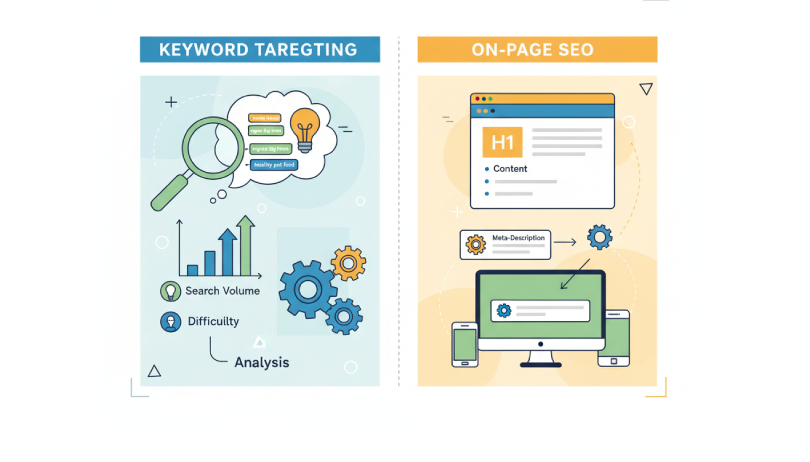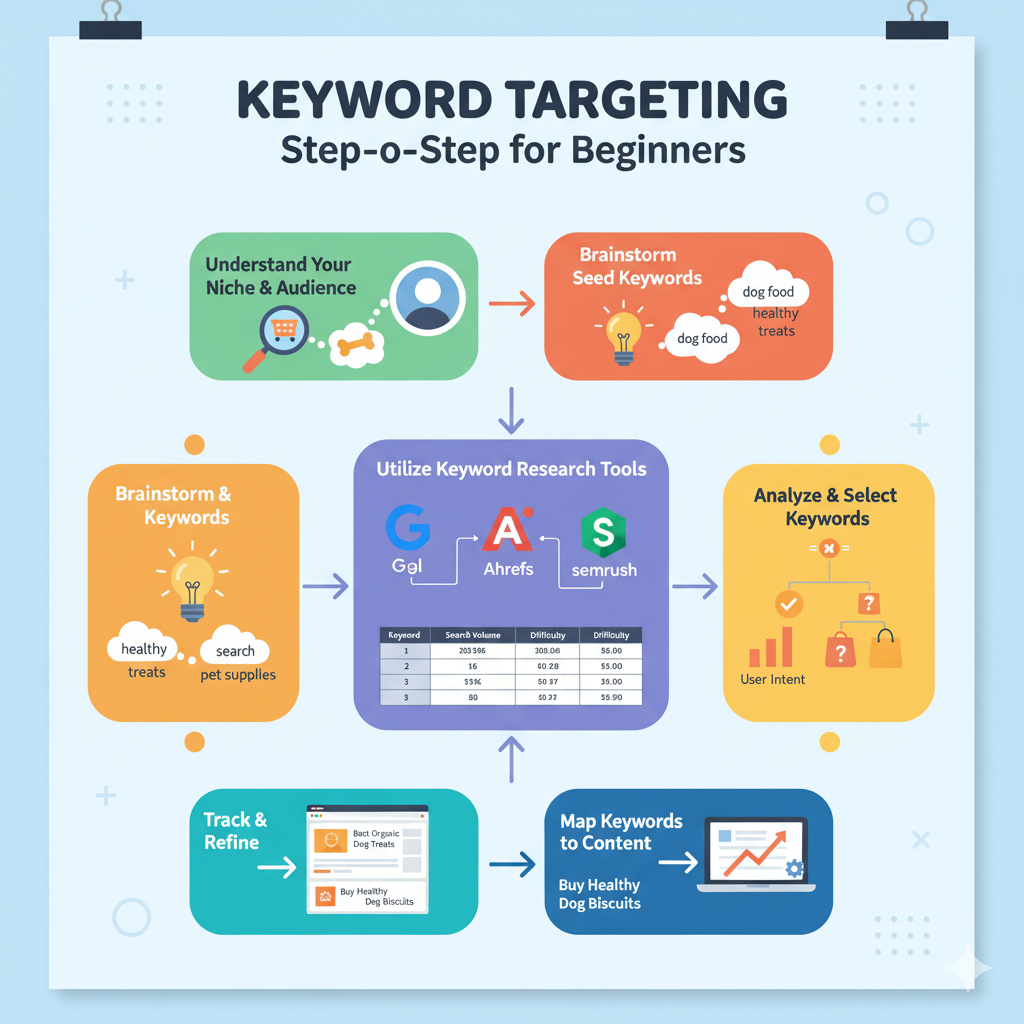
Keyword targeting step by step for beginners
Targeting keywords and optimizing on page SEO is essential for any website that wants to succeed online. In fact, following A visual guide to keyword targeting and on page SEO can make a huge difference: any site that produces content without proper keyword research and strategic placement, even if the content is high quality, has a much lower chance of ranking in search results. By understanding which phrases users are searching for and implementing them thoughtfully within your page, you can boost your site’s ranking while also improving the overall user experience.
Table of Contents
Why Keyword Targeting Matters
Keyword targeting means identifying the exact and relevant phrases that users search for on Google or other search engines. Without proper targeting, your content may not align with users’ real needs and can even increase bounce rates. For example, if you write an educational article about “on page SEO” but your keywords focus on “buying SEO tools,” the user will not achieve their goal, resulting in a negative user experience. Proper keyword targeting ensures that your content is both understandable for search engines and engaging for your audience.
SEO SERVICE FOR YOU
Boost your website traffic and grow your business
Choosing Primary and Secondary Keywords
The primary keyword is the phrase that forms the core of your content, such as “on page SEO.” This keyword should appear in key areas of the page, including the title, H1, and URL.
Secondary or related keywords are phrases that support the main topic and help search engines better understand the context of your page. Examples include “keyword targeting,” “meta and title optimization,” “image Alt Text,” and “internal linking.”
When selecting keywords, it’s also important to consider the user’s search intent. Users may be looking for information (Informational), making a purchase (Transactional), or comparing options (Navigational). Choosing the wrong keywords can result in content that doesn’t align with users’ real needs, causing visitors to leave the page quickly.
Placing Keywords on the Page
- After selecting your keywords, the most important step is placing them correctly within your content:
- Page Title (Title Tag): Include the primary keyword, keep it short, engaging, and compelling for users to click.
- Headings (H1, H2, H3): Use the primary keyword in H1, and secondary keywords or user questions in H2/H3.
- Page URL: Keep it short, clear, and include the keyword.
- Main Content: Use keywords naturally within the text without overstuffing.
- Meta Description: A concise and attractive summary that includes both primary and secondary keywords.
- Image Alt Text: Provide a precise description of the image, incorporating relevant keywords.

Using Images, Charts, and Videos
Images, charts, and videos not only enhance the user experience but also help search engines better analyze the page content. Adding schema markup and structured data can increase the chances of your content appearing in rich results, such as Rich Snippets. An important point is to optimize image file sizes and their Alt Text to ensure page load speed is not compromised and technical SEO remains intact.
Continuous Monitoring and Optimization
No SEO strategy is complete without ongoing analysis. Tools like Google Analytics and Google Search Console help you:
- Monitor the performance of pages and keywords
- Identify pages with high bounce rates or low CTR and make necessary improvements
- Use A/B testing for titles and meta descriptions to increase click through rates
- Additionally, JetSEO Pro offers continuous keyword monitoring and suggests data driven changes, making this process much easier.
What is the Difference Between Short tail and Long tail Keywords, and Which One is Better?
Short tail keywords are broad, general search terms, usually one to two words long, that cover a wide topic. For example, “SEO” or “digital marketing.” They typically have high search volume but also high competition, making it more difficult for new or smaller websites to rank for them. While short tail keywords can drive a lot of traffic, the visitors may be less targeted because the search intent can vary widely.
Long tail keywords, on the other hand, are longer, more specific phrases, usually three or more words, like “on page SEO tips for small businesses in Canada” or “best SEO tools for dental clinics in Toronto.” These keywords have lower search volume, but the traffic they bring is often more qualified and conversion focused because the intent is clearer.
Which is better? The answer depends on your goals:
For new websites or niche businesses: Long tail keywords are generally more effective because they face less competition and attract users who are ready to take action.
For brand awareness and high traffic goals: Short tail keywords can help increase visibility, but they require more effort, higher quality content, and often stronger backlink profiles to compete.
Best strategy: A combination of both. Use short tail keywords to build overall visibility and awareness, while targeting long tail keywords for conversions, engagement, and highly specific searches.
Additionally, long tail keywords are excellent for local SEO, which is crucial for Canadian businesses targeting specific cities or regions, like “Vancouver SEO consultant” or “SEO Services Toronto” They help attract users who are more likely to become leads or customers.
Key takeaway: Short tail keywords drive broad traffic, long tail keywords drive targeted traffic, and a balanced strategy using both types will maximize your SEO effectiveness.
How Often Should Keywords Be Used in Content?
One of the most common concerns in SEO is keyword stuffing, which occurs when a keyword is overused in a way that feels unnatural or forced. This can hurt your rankings because search engines like Google prioritize content that is valuable and readable for users, not content that is just filled with repeated keywords.
Guidelines for keyword usage:
Use keywords naturally
Incorporate your primary and secondary keywords where they make sense in sentences. Focus on clarity and flow, rather than hitting a specific number.
Keyword density: While there is no strict rule, a good benchmark is around 1–2% for the primary keyword meaning 1–2 times per 100 words but this is flexible. Overstuffing can trigger penalties or reduce readability.
Use variations and synonyms
Include LSI (Latent Semantic Indexing) keywords, synonyms, and related phrases to reinforce the topic without repeating the exact keyword excessively. For example, if your primary keyword is “on page SEO,” you can also use “on site optimization,” “SEO best practices,” or “SEO page optimization.”
Prioritize key locations: Place keywords in strategic positions like the title, H1, H2 headings, meta description, first paragraph, and image Alt Text. This is more effective than repeating the keyword many times in the body.
Write for the user first: If your content is engaging, thorough, and helpful, keywords will naturally appear in the right context, and search engines will recognize the relevance without overuse.
Key takeaway
Focus on quality and relevance over quantity. Use your primary keyword where it matters most, supplement with related terms, and always prioritize readability and user experience
Conclusion
By properly implementing keyword targeting and on page SEO, your pages become understandable for search engines while providing a valuable and engaging experience for users. Tools like JetSEO Pro streamline the process of keyword research, placement, and monitoring, resulting in improved search rankings and making it easier for your target audience to find your site.
FAQ
What is keyword targeting in SEO?
Keyword targeting is the process of identifying and using specific phrases that users search for on search engines. Proper keyword targeting ensures your content matches user intent and ranks higher in search results.
What is on page SEO?
On page SEO refers to optimizing individual web pages to improve search engine rankings and user experience. This includes using keywords strategically, optimizing headings, meta tags, URLs, images, and internal linking.
How do I choose the right keywords for my content?
Start by understanding your audience and their search intent. Use tools like JetSEO Pro, Google Keyword Planner, or Ahrefs to find relevant keywords. Include a mix of primary (main topic) and secondary (related) keywords to cover the topic comprehensively.
What is the difference between short tail and long tail keywords?
Short tail keywords are broad and general (e.g., “SEO”), while long tail keywords are specific and detailed (e.g., “on page SEO tips for small businesses in Toronto”). Long tail keywords usually have lower competition and attract more qualified traffic.
How often should I use keywords in my content?
Use keywords naturally, focusing on readability. A rough guideline is around 1–2% keyword density, but more importantly, use variations and related phrases to reinforce the topic without overstuffing.
Where should I place keywords on the page?
Keywords should appear in the title, H1, H2 headings, meta description, URL, first paragraph, and image Alt Text. Strategic placement is more important than sheer frequency.
Can images and videos help with on page SEO?
Yes! Images, charts, and videos improve user engagement and help search engines understand the content better. Adding Alt Text, optimizing file sizes, and using schema markup increases the chances of appearing in rich results.
Related Posts
Learn what SEO is and why it's crucial for your business. Find out how optimizing your website can boost…
by
Having a great website is just the first step. To get people to visit it, they need to be…
by
As voice search becomes more popular, it's clear that people are changing how they look for information online. Users…
by
With the rise of zero-click searches, ranking at the top of Google's search results has taken on a new…
by


